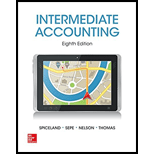
Concept explainers
Requirement – 1
Financial ratio:
The financial ratios examine the performance of the company, and used in comparing own business with other same business. It indicates the relationship of two or more items of financial statements.
To calculate: The inventory turnover ratio of Company A for the year 2016.
Requirement – 1
Explanation of Solution
Inventory Turnover:
It is a part of
Given, ($ in millions)
Cost of goods sold is $6,300
Opening inventory is $800
Closing inventory is $600
Hence, the inventory turnover ratio of Company A is 9 times.
Requirement – 2
To calculate: The average days in inventory of Company A for the year 2016.
Requirement – 2
Explanation of Solution
Average days in inventory:
Days’ in inventory are used to determine number of days a particular company takes to make sales of the inventory available with them.
Here,
Inventory turnover ratio is 9 times (Refer to requirement (1))
Number of days in the year are 365
Hence, the average days in inventory of Company A are 40.56 days.
Requirement – 3
To calculate: The receivable turnover ratio of Company A for the year 2016.
Requirement – 3
Explanation of Solution
The accounts receivable turnover ratio determines the efficiency of a company to use its assets and issue the credit to the customers and collects the funds from them. The accounts receivable turnover is determined by dividing the credit sales by the average accounts receivable of that accounting period.
Given, ($ in millions)
Sale is $9,000
Opening account receivable is $600
Closing account receivable is $400
Hence, the receivables turnover ratio of Company A is 18 times.
Requirement – 4
To calculate: The average collection period of Company A for the year 2016.
Requirement – 4
Explanation of Solution
Average collection period:
Average collection period is used to determine the number of days a particular company takes to collect accounts receivables.
Here,
Receivables turnover ratio is 18 times (Refer to requirement (3))
Number of days in the year are 365
Hence, the average collection period of Company A is 20.28 days.
Requirement – 5
To calculate: The asset turnover ratio of Company A for the year 2016.
Requirement – 5
Explanation of Solution
Assets Turnover:
Asset turnover is a ratio that measures the productive capacity of the fixed assets to generate the sales revenue for the company. Thus, it shows the relationship between the net sales and the average total fixed assets.
Here, ($ in millions)
Sale is $9,000
Opening assets is $4,000
Closing assets is $3,600
Hence, the assets turnover ratio of Company A is 2.37 times.
Requirement – 6
To calculate: The profit margin on sales of Company A for the year 2016.
Requirement – 6
Explanation of Solution
Profit Margin:
Profit margin reflects the portion of net income in the net sales. It is a profitability measure tool that is used to evaluate the net income a business earns on every dollar of net sales.
Given, ($ in millions)
Net income is $300
Sales are $9,000
Hence, the profit margin on sales of Company A is 3.33%.
Requirement – 7
To calculate: The return on assets of Company A for the year 2016.
Requirement – 7
Explanation of Solution
Return on Assets:
It evaluates the efficiency of company’s assets. It reports the profit earned as the percentage of total assets used in the business. A company’s
Given, ($ in millions)
Net profit is $300
Opening assets is $4,000
Closing assets is $3,600
Hence, the return on assets of Company A is 7.89%.
Requirement – 8
To calculate: The return on shareholders’ equity of Company A for the year 2016.
Requirement – 8
Explanation of Solution
Return on shareholder’s equity:
It measures the net income available to common shareholders of the company. A company’s rate of return on equity shows the amount earned for each dollar invested by the common shareholders.
Given, ($ in millions)
Sale is $9,000
Opening paid-in-capital is $600
Opening
Closing paid-in-capital is $600
Closing retained earnings is 7500
Hence, the return on shareholders’ equity of Company A is 21%.
Requirement – 9
To calculate: The equity multiplier of Company A for the year 2016.
Requirement – 9
Explanation of Solution
Given, ($ in millions)
Opening assets is $4,000
Closing assets is $3,600
Opening paid-in-capital is $600
Opening retained earnings is $900
Closing paid-in-capital is $600
Closing retained earnings is 7500
Hence, the equity multiplier of Company A is 2.67.
Requirement – 10
To calculate: The return on shareholders’ equity under DuPont framework of Company A for the year 2016.
Requirement – 10
Explanation of Solution
Here,
Profit margin on sales is 3.33% (Refer to requirement (6))
Assets turnover ratio is 2.37 (Refer to requirement (5))
Equity multiplier is 2.67 (Refer to requirement (9))
Hence, the return on shareholder’s equity under DuPont framework of Company A is 21.1%.
Want to see more full solutions like this?
Chapter 5 Solutions
INTERMEDIATE ACCOUNTING W/CONNECT PLUS
- I am searching for the correct answer to this general accounting problem with proper accounting rules.arrow_forwardCan you help me solve this general accounting question using valid accounting techniques?arrow_forwardPlease provide the accurate answer to this general accounting problem using appropriate methods.arrow_forward

 AccountingAccountingISBN:9781337272094Author:WARREN, Carl S., Reeve, James M., Duchac, Jonathan E.Publisher:Cengage Learning,
AccountingAccountingISBN:9781337272094Author:WARREN, Carl S., Reeve, James M., Duchac, Jonathan E.Publisher:Cengage Learning, Accounting Information SystemsAccountingISBN:9781337619202Author:Hall, James A.Publisher:Cengage Learning,
Accounting Information SystemsAccountingISBN:9781337619202Author:Hall, James A.Publisher:Cengage Learning, Horngren's Cost Accounting: A Managerial Emphasis...AccountingISBN:9780134475585Author:Srikant M. Datar, Madhav V. RajanPublisher:PEARSON
Horngren's Cost Accounting: A Managerial Emphasis...AccountingISBN:9780134475585Author:Srikant M. Datar, Madhav V. RajanPublisher:PEARSON Intermediate AccountingAccountingISBN:9781259722660Author:J. David Spiceland, Mark W. Nelson, Wayne M ThomasPublisher:McGraw-Hill Education
Intermediate AccountingAccountingISBN:9781259722660Author:J. David Spiceland, Mark W. Nelson, Wayne M ThomasPublisher:McGraw-Hill Education Financial and Managerial AccountingAccountingISBN:9781259726705Author:John J Wild, Ken W. Shaw, Barbara Chiappetta Fundamental Accounting PrinciplesPublisher:McGraw-Hill Education
Financial and Managerial AccountingAccountingISBN:9781259726705Author:John J Wild, Ken W. Shaw, Barbara Chiappetta Fundamental Accounting PrinciplesPublisher:McGraw-Hill Education





